|
Well folks, I have just come next to last in a SLOP contest.
For those not in the know, SLOP stands for Slow Open Power free
flight, which means:
- No auto-rudder
- No VIT
- No Pressure feed
- Plain bearing engines up to 3.5 cc only
In other words, back to the 50’s style free-flight power.
There are many wonderful designs from that period, magical
names, such as Eliminator, Posthole Digger, Lipstick, Sweet
Daddy Pearl, Skystreak, Starduster, and here in the civilised
world, the grand champion of all time, the Dixielander.
It seems there is renewed interest in the Dixielander by those
who remember the flood. Back in 1959, Jim Baguley wrote in
“Model Aircraft” a defining series of articles called “Power
Duration Models”. The date was December, 1959, and on the cover
was a Ta 154, the German “Mosquito”. It might then seem strange
that a proven loser like myself may choose to revisit this
topic, but my regular readers know that a swollen ego like mine
lets me look down on even people who are taller than me!
However, for the folk I see trying F/F and didn’t see the
rainbow, it might be worth a few words of refreshment on
trimming SLOP’s. I shall couch my words as being authoritative,
as recently I had a dream. In the dream, God was abusing me for
using weasel words like “perhaps”, “ could be”, “if”, and
“etcetera”. This is what he said. “Supercool, I have given you
the gift of life. Stride forth upon the Earth and enlighten the
modellers of the world. Be not timid. Go forth. Go out with a
bang, not a whimper. Trust your own judgement. Invest in your
own talents”.
Well, with encouragement like that from on high, I sincerely
recommend that you read on. Its not just me He is watching!
There are to my certain knowledge 3 George Fuller Dixielanders.
Here are some pics, one of modified Dixi 2000 and one of Dixi
2000 plan.
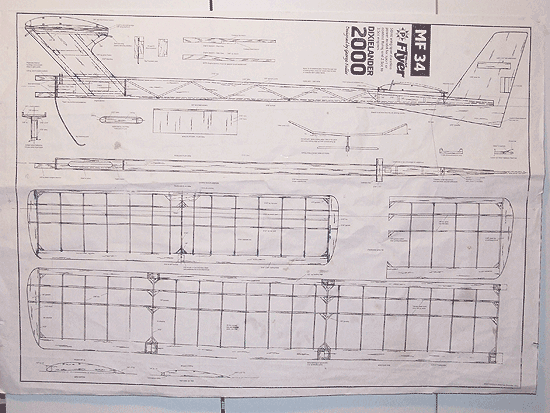
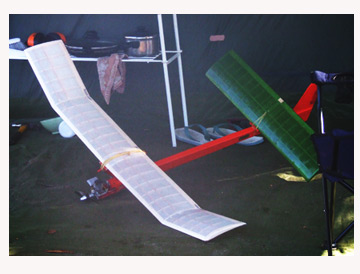
The Yeoman kit version, the E-type and the Dixielander 2000.
They run something like this:
- Yeoman kit. 3/8” washout at the tips, 3/8” washin on the
right inner panel, heaps of tail tilt and relatively low
power. OS15 Max 3, various 2,5cc diesels, probably a maximum
of 0.3 HP
- E-type. Washout and washin reduced to ¼”, longer tail
moment, more power in the form of Eta 29, probably about .5
HP
- Dixielander 2000. Much the same as the E-type, but
rather surprisingly, no tail tilt shown on the plan. Hmm,
looks like a mistake to me.
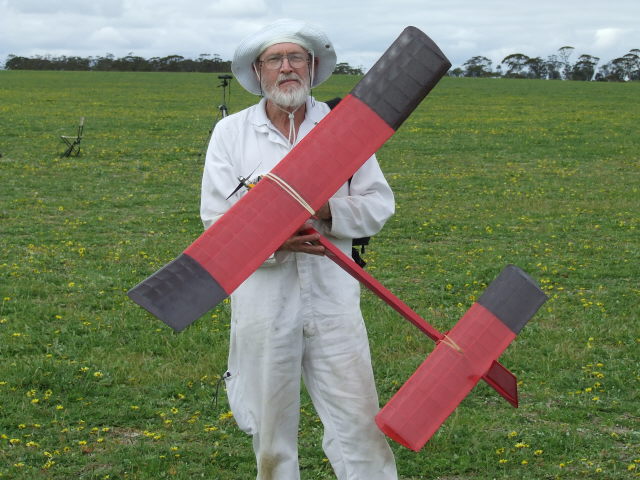
So we are looking at a model with built in trim. The washin
gives a right spiral, and the tail tilt the glide turn. But
there are devils in the detail. Here is rule number one for
launching Dixielanders.
Rule 1. The launch of the model must be with
the wings banked into the power turn, to the right of the wind,
and nose up at an angle commensurate with the installed power.
With Rule 1 followed, the model will go into some sort of right
spiral. This is not a left roll. Right rudder tab will increase
the number of turns in the spiral, and left tab will reduce the
number of turns. The thing to watch for is the model chasing its
tail round and around, thereby reducing the climb height.
You really only want about 3 turns in 10 seconds. This will put
the model into a good position for the transition into glide. It
should do glide turns to the right, set by the tail tilt
(starboard tip high). If the turn to the right does not appear,
and the climb is too spirally, there is a C/G problem. Tail tilt
only works if the tailplane is carrying a sufficient share of
the model weight, which means rearward C/G.
The model doing too many turns in the spiral can be both a C/G
problem and a trim tab setting problem. Here is Rule 2.
Rule 2. If the model does not turn to the right
on the glide, move the C/G back. (This assumes you have plenty
of tail tilt)
The plan probably shows the C/G on the trailing edge. This
position is not carved in stone. My 2000 has the C/G 20mm back
from the trailing edge. By now, the only remaining problem is to
get the number of turns in the spiral right. Here is Rule 3.
Rule 3. Increase the number of turns with more
right tab. Decrease them with left tab, even if it means the tab
actually goes left. 3 turns in 10 seconds is about right.
The last problem is running the motor on suction. Small
venturi’s give low power. You want the hole in the venturi as
large as you can get it and still be able to tune the engine. On
my OS20, the engine burps a little after launch due to
starvation, but then picks up again. That is about as big a hole
as I dare run.
Hope this epistle is of help to someone out there. If so, send
cash, no cheques.
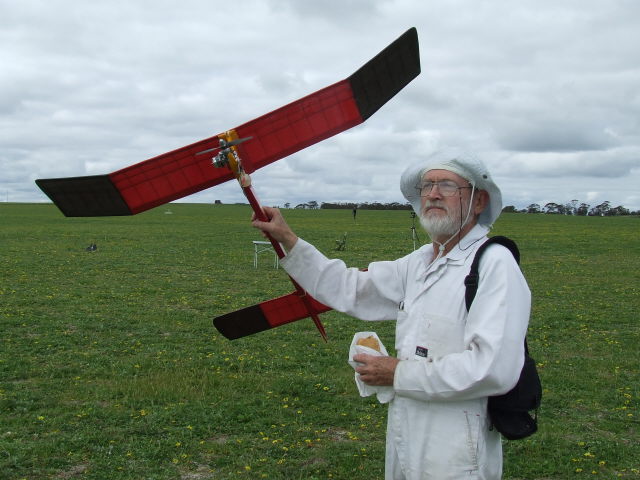
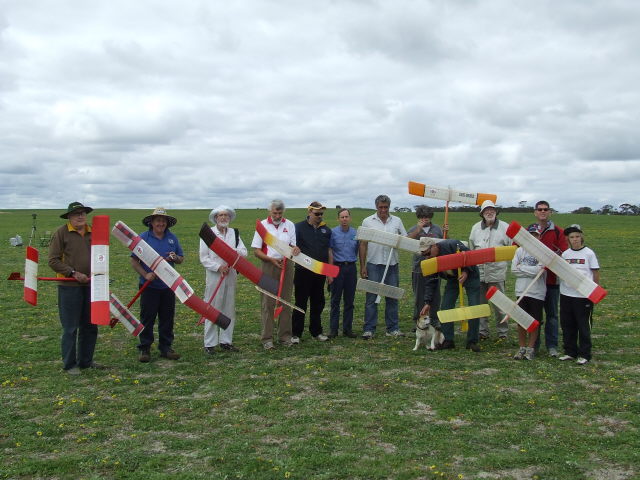
Dixie addendum:
Subsequent to the 50th centenary of the Dixielanders birth
and the 63 rd MAAA Nationals hosted by the VMAA in
Albury-Wodonga, some reflection on the handling of the
Dixie may be appropriate.
The first flights of a new Dixie can be fraught. If you have no
short DT facility, you need to get the model up fairly high
in case the pattern and transition are poor, in which case
you might hit the ground. Not good.
The key here is that the Dixie does need right rudder tab.
With low power, you may need up to 3mm deflection of the
tab to overcome the right wing washin and get your spiral.
With higher power, you need less tab, maybe only 1mm.
My own experience at the Nats contains a salutary lesson.
I had planned to run OS CZ11 on 40% nitro using my own
7X4 prop. For some reason I can't fathom, I found myself
with no 7X4 props on hand and so retrimmed on a cut down
8X3.5 on a hot morning several days before the contest.
Performance was way down, but you have to go with what
you've got.
On the morning of the contest, the day was cool and
conditions good for engine power. I chose not to retrim, which
was a big mistake, as the little OS picked up at least 2000
RPM, which I welcomed. But I had a lot of right trim-tab
from the previous session, and this proved way to much for
the extra power, the model chasing its tail rather than climbing.
Another problem with the Dixie is launching in moderate winds.
The usual right bank into wind results in the model being blown
flat down wind. If it doesn't impact, you still lose about 3
seconds of motor run before the model assumes its correct
trajectory. I have no cure for this, but wonder if a downwind
launch might work. Scary.
On the subject of winds, here in the West the models need to be
strong enough to be blown over on there backs, and even tumbled
a few times. I use spruce spars with dihedral braces, and spruce
longerons in the corners of the fuselage box. Adds weight, but
the model does not need constant repairs on the field.
The final problem concerns the Dixie fin, or should I say problems.
The overhanging fin trailing edge saves a gram or two, but is
vulnerable. If the model DT's close to the ground, it can tail slide
onto the fin and snap it off.
In addition, the fin is only 1/8th sheet, and essentially unsupported
past the fuselage rear. In hot, dry weather, warpage can occur
thus changing the effective amount of rudder tab. The inserted
fin brace serves only to weaken the fin. I use 3/16 quarter grain
for the fin, no brace and extend the fuselage to the rear of the fin.
Also, I find a screw adjustable rudder tab desirable for precise
adjustment on the day.
So there it is. Good luck with your Dixies, still a hot ship after 50
years!
|